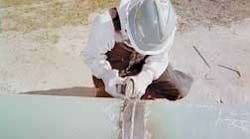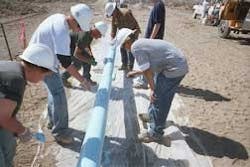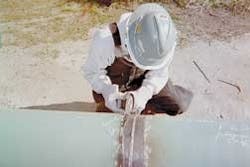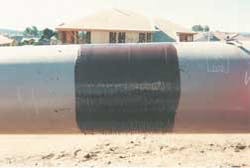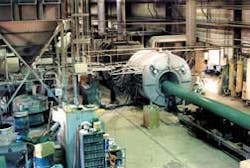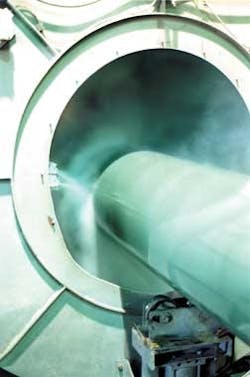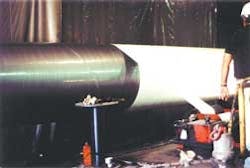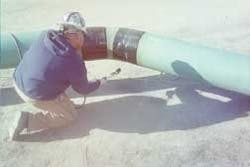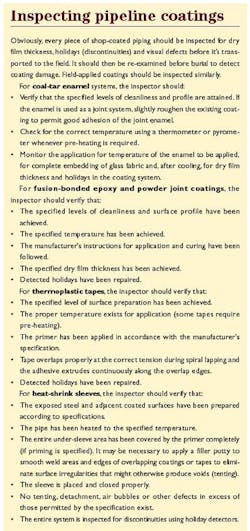People have buried valuables in the ground since prehistoric times, but as any archeologist will tell you, that's not necessarily the optimum choice for long-term survival. Heat, cold, seismic forces, bugs, bacteria and who-knows-what-else can be more of a threat to the structural integrity of the buried item than any marauders. The same kinds of threats that eventually destroy the buried treasure of Discovery Channel fame will wreak havoc with your buried piping systems as well.
The solution to the problem is pipeline coating, which provides barrier protection, insulation or other required properties for your metal piping, but getting the right coating for the right application requires some planning.
Figure 1. Field repair of coating damaged during transportation to site.
Because organic coatings are seldom applied perfectly and always are subject to deterioration during service, buried and immersed pipelines are normally protected cathodically. Indeed, many countries, including the United States, require cathodic protection on buried and immersed gas and oil lines.
A pipeline coating with a high electrical resistance significantly reduces the electrical current required to achieve effective cathodic protection, which in turn protects any exposed pipeline metal from deterioration. If coatings are to perform well in conjunction with cathodic protection, the cathodic protection voltage must be maintained at some minimum level, and the coatings must be resistant to the alkalinity that cathodes produce.
Pipe coating properties
To be considered effective, pipeline coatings must have the following physical and chemical properties:
Good electrical resistance
. The coating must provide a barrier that protects the steel from aggressive electrolytes in the soil or water.Good chemical resistance
. The coating must be resistant to chemical attack by its environment.Resistance to cathodic disbonding
. Cathodic protection can ruin a coating by driving water through it or by producing hydrogen gas on the steel that separates it from the metal should the cathodic voltage exceed 1.1 volt.Good adhesion to metal surface
. Adhesion is required to minimize coating damage during shipment, handling and service.Heat resistance
. In services where the piping is heated, the coating system must be resistant to the prevailing temperatures.Ease of application
. The coating must be relatively easy to apply to form a quality film; thus, coatings normally perform better when shop-applied under controlled conditions than when field-applied.Resistance to damage during handling, storage and installation
. The coating must have sufficient resistance to impact and abrasion and have good ductile properties to resist mechanical damage during handling, storage and installation. Coatings subjected to extended exterior exposure also must be resistant to deterioration by the sun's ultraviolet light.Ease of repair
. It must be easy to repair damage from handling, storage, transport and installation (see Figure 1). Welded construction damages coated areas and necessitates repairs. Thus, common practice is to leave areas uncoated where welding is to occur. The cut-back distance necessary for preventing heat damage ranges from about six inches for a polyethylene coatings to one inch for a fusion-bonded epoxy coatings. Laser welding generates much less heat and causes much less coating damage that the usual welding equipment.In addition, joint coatings used on weld areas of pipelines have a few special requirements:
The weld must be ground relatively smooth and any weld spatter removed (see Figure 2).
The joint coating must be compatible with the pipe coating.
The application temperature must not exceed the temperature limit of the pipe coating.
The joint coating must adhere well to both the cleaned metal and the pipe coating (see Figure 3).
Figure 2. Grinding of girth weld for coating.
Figure 3. Liquid coating applied to girth weld.
Coating joints with coal tar
Coal tar can be used to coat joints if the coating on the rest of the pipe contains coal tar or asphalt. More commonly, though, joints are coated with cold-applied polyvinyl chloride or polyethylene tapes having a synthetic rubber adhesive, which may then further be protected with heat-shrink sleeves.
A common practice is to furnish factory-coated pipe in 20- 40- or 80- foot lengths, which are field-welded together on the job site. Cleaning the exposed end metal and applying a joint coating completes the connection.
Because of health and environmental concerns, portable containment systems for both surface preparation and weld coating application are becoming more popular. A less-common practice is to weld the complete line together, clean the piping and apply the coating in the field (over the ditch) in one continuous, seamless operation. This eliminates damage during transportation and handling. However, field conditions are often unsuitable for coating application.
Immersed pipelines
Pipelines laid in seas, rivers or lakes are typically installed from lay barges, which are specially designed to permit welding shop-coated piping and repairing weld coatings. Occasionally, marine piping is welded and coated ashore before being towed into position.
Submerged pipe sizes greater than eight to 12 inches typically require a concrete weight coating applied over the corrosion-resistant coating to prevent floating. In some cases, pre-cast concrete weights may be used instead to keep the line under water.
Coal-tar and asphalt
Coal-tar enamels and asphalt were the first coatings to be used on buried pipelines. They were reasonably cheap and easy to apply, and they required only a low level of metal cleaning in preparation for coating. Presently, most coal-tar systems consist of primer, coal tar, glass fabric and felt. Additional coal tar and felt layers can be used to increase the thickness.
Coal tar and asphalt systems can be applied in the shop or field, but performance has been notably better when shop- rather than field-applied (See Figure 4). If coal tar or asphalt is exposed to the sun for long periods, it may be necessary to apply a whitewash or paper on them to prevent ultraviolet degradation.
Figure 4. Pipe entering die for extrusion application of coal-tar coating. (Courtesy of Dura Bond Coating, Inc.)
Several states prohibit or discourage the use of coal tar coatings because of concerns about heath and safety. Coal tar contains polycyclic aromatic compounds, some of which are carcinogenic. When coal tar is heated for application, many of these compounds vaporize.
Being much less aromatic than coal tar, asphalt contains fewer carcinogenic compounds, but its use also is restricted in some locations. Asphalt mastics consist of a dense mixture of sand, crushed rock and fiber bound with asphalt. These mastics normally require a primer.
Fusion-bonded epoxies
A fusion-bonded epoxy coating consists of a thermosetting powder applied electrostatically to electrically grounded metal components (see Figure 5 and 6). Heating in an oven fuses the powder into a hard, continuous, cured film. A high level of cleaning and precise application are necessary for outstanding performance.
Figure 5. Overview of powder coating chamber.
Figure 6. Applying powder coating. (Both courtesy of Dura Bond Coating, Inc.)
North America currently seems to prefer these coating systems for buried and immersed pipelines. Europe favors the three-layer, fusion-bonded epoxy-polyolefin system.
Fusion-bonded epoxy coatings may be thin and brittle one-layer systems (with good resistance to soil stresses) or two-layer thicker systems with greater resistance to mechanical damage and high temperature. These coatings also are used as primers for two coats of polyolefin. The fusion-bonded epoxy provides good adhesion to the pipe and polyolefin, as well as good resistance to mechanical and environmental degradation.
Polyolefins
Polyethylene and polypropylene coatings are the common olefins used for coating buried or immersed pipelines. These plastics were originally applied by sintering (baking the sprayed material) or by hot extrusion over a soft adhesive. However, hot extrusion sometimes resulted in poorly adhering films that later cracked.
The development of a three-layer, fusion-bonded epoxy-polyolefin system resolved earlier problems. These systems typically consist of a coat of fusion-bonded epoxy, a coat of fusion-bonded epoxy copolymer with polyethylene or polypropylene and a top coat of polyethylene or polypropylene.
The polypropylene system is commonly used in Europe and has excellent heat-resistance. One authority states that the three-coat FBE-PP system is the only anti-corrosive system appropriate for temperatures above 194F.
Tape wraps
Tape coatings for piping became popular in the early 1960s. They consist mostly of polyethylene or polyvinylchloride backing with a thermoplastic adhesive. They require only a low level of surface preparation and are easily applied to piping, but they are susceptible to soil stress problems. The loss of plasticizer over time embrittled the PVC version. Tapes can be shop-or field-applied, and are often applied to field joints by hand (see Figure 7).
Figure 7. Applying tape to pipe in shop. (Courtesy of Dura Bond Coating, Inc.)
Cold-applied petrolatum tape and petroleum wax tape coatings consist of a petrolatum or wax primer and a covering of loosely woven tape saturated with the petrolatum or wax. This coating isn't recommended for immersion use.
Heat-shrink sleeves
These sleeves may be used to protect weld areas from corrosion. The basic sleeve types include a seamless tubular version that must be slid over an end of the piping before the joint is made, and a wrap-around version that can be sealed with a heat-activated closure strip or a mechanical zipper (see Figure 8).
Figure 8. Heat shrinking of sleeve material in the field.
Significant improvements have been made in coating systems for buried and immersed pipelines during the last 50 years. As environmental concerns or new operational requirements arise, the materials are likely to evolve further. For the near future, fusion-bonded epoxy and three-layer fusion-bonded epoxy-olefin systems are expected to dominate at the expense of coal-tar and asphalt.
This article is an excerpt from the book Good Painting Practice, SSPC Painting Manual, Volume 1, 4th Edition, and is used with the permission of SSPC: The Society for Protective Coatings, Pittsburgh. It appears here in an edited version.
Dr. Richard W. Drisko is Senior Technical Advisor to SSPC: The Society for Protective Coatings, Pittsburgh. He can be reached at 412-281-2331.
